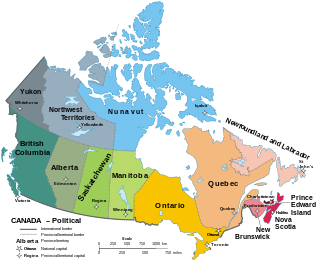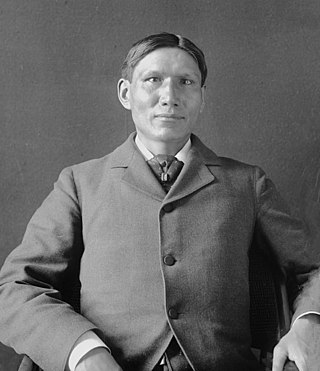Related Research Articles

Canada has ten provinces and three territories that are sub-national administrative divisions under the jurisdiction of the Canadian Constitution. In the 1867 Canadian Confederation, three provinces of British North America—New Brunswick, Nova Scotia, and the Province of Canada —united to form a federation, becoming a fully independent country over the next century. Over its history, Canada's international borders have changed several times as it has added territories and provinces, making it the world's second-largest country by area.

A credit union, a type of financial institution similar to a commercial bank, is a member-owned nonprofit financial cooperative. Credit unions generally provide services to members similar to retail banks, including deposit accounts, provision of credit, and other financial services. In several African countries, credit unions are commonly referred to as SACCOs.
Global Affairs Canada is the department of the Government of Canada that manages Canada's diplomatic and consular relations, promotes Canadian international trade, and leads Canada's international development and humanitarian assistance. It is also responsible for maintaining Canadian government offices abroad with diplomatic and consular status on behalf of all government departments.

The Communist Party of Canada is a federal political party in Canada, founded in 1921 under conditions of illegality. Although it does not currently have any parliamentary representation, the party's candidates have previously been elected to the House of Commons, the Ontario legislature, the Manitoba legislature, and various municipal governments across the country. The party has also made significant contributions to Canada's trade union, labour, and peace movements.

The American Indian Movement (AIM) is a Native American grassroots movement which was founded in Minneapolis, Minnesota in July 1968, initially centered in urban areas in order to address systemic issues of poverty, discrimination, and police brutality against Native Americans. AIM soon widened its focus from urban issues to many Indigenous Tribal issues that Native American groups have faced due to settler colonialism in the Americas. These issues have included treaty rights, high rates of unemployment, Native American education, cultural continuity, and the preservation of Indigenous cultures.
Little People of America (LPA) is a 501(c)(3) non-profit organization which provides support, resources, and information to individuals with dwarfism and their families.
Andrew Mitchell, is a Canadian politician. He served in the House of Commons of Canada from 1993 to 2006, representing Parry Sound—Muskoka as a member of the Liberal Party. He was a minister in the government of Jean Chrétien and a cabinet minister in the government of Paul Martin.

The Métis are Indigenous peoples whose historical homelands includes Canada's three Prairie Provinces, as well as parts of British Columbia, the Northwest Territories, Northwest Ontario and the Northern United States. They have a shared history and culture, deriving from specific mixed European and Indigenous ancestry, which became distinct through ethnogenesis by the mid-18th century, during the early years of the North American fur trade.
Matching funds are funds that are set to be paid in proportion to funds available from other sources. Matching fund payments usually arise in situations of charity or public good. The terms cost sharing, in-kind, and matching can be used interchangeably but refer to different types of donations.
First Nations in Alberta are a group of people who live in the Canadian province of Alberta. The First Nations are peoples recognized as Indigenous peoples or Plains Indians in Canada excluding the Inuit and the Métis. According to the 2011 Census, a population of 116,670 Albertans self-identified as First Nations. Specifically there were 96,730 First Nations people with registered Indian Status and 19,945 First Nations people without registered Indian Status. Alberta has the third largest First Nations population among the provinces and territories. From this total population, 47.3% of the population lives on an Indian reserve and the other 52.7% live in urban centres. According to the 2011 Census, the First Nations population in Edmonton totalled at 31,780, which is the second highest for any city in Canada. The First Nations population in Calgary, in reference to the 2011 Census, totalled at 17,040. There are 48 First Nations or "bands" in Alberta, belonging to nine different ethnic groups or "tribes" based on their ancestral languages.
The Little Shell Band of Chippewa Native Americans are a historic sub-band of the Pembina Band of Chippewa Indians led by Chief Little Shell in the nineteenth century. Based in North Dakota around the Pembina River, they are part of the Ojibwe, one of the Anishinaabe peoples, who occupied territory west of the Great Lakes by that time. Many had partial European ancestry from intermarriage by French-Canadian fur traders and trappers. Some began to identify as Métis, today recognized as one of the Indigenous Peoples of Canada. Located in the 17th century in the areas around the Great Lakes, they gradually moved west into North Dakota and Montana.

The International Union of the Guides and Scouts of Europe - Federation of Scouts of Europe is a traditional faith-based Scouting organization with 20 member associations in 17 European countries and also in North America, serving roughly 65,000 members. The organization, headquartered in France, was founded in 1956 by a group of German and French Roman Catholic Scoutmasters as a faith-based Scouting movement, in order to reconcile the European peoples in the aftermath of the Second World War.
Numeris is a Canadian audience measurement organization. Established on May 11, 1944 as a division of the Canadian Association of Broadcasters, Numeris is the primary provider of viewership numbers for television and radio broadcasters in Canada.
In Canada, an Indian band or band, sometimes referred to as a First Nation band or simply a First Nation, is the basic unit of government for those peoples subject to the Indian Act. Bands are typically small groups of people: the largest in the country, the Six Nations of the Grand River First Nation had 22,294 members in September 2005, and many have a membership below 100 people. Each First Nation is typically represented by a band council chaired by an elected chief, and sometimes also a hereditary chief. As of 2013, there were 614 bands in Canada. Membership in a band is controlled in one of two ways: for most bands, membership is obtained by becoming listed on the Indian Register maintained by the government. As of 2013, there were 253 First Nations which had their own membership criteria, so that not all status Indians are members of a band.
The Canadian Museums Association, is a national non-profit organization for the promotion of museums in Canada. It represents Canadian museum professionals both within Canada and internationally. As with most trade associations, it aims to improve the recognition, growth and stability of its constituency. Its staff supports their nearly 2,000 members with conferences, publications, and networking opportunities.

The Dakota are a Native American tribe and First Nations band government in North America. They compose two of the three main subcultures of the Sioux people, and are typically divided into the Eastern Dakota and the Western Dakota.
A province is almost always an administrative division within a country or state. The term derives from the ancient Roman provincia, which was the major territorial and administrative unit of the Roman Empire's territorial possessions outside Italy. The term province has since been adopted by many countries. In some countries with no actual provinces, "the provinces" is a metaphorical term meaning "outside the capital city".
Pan-Indianism is a philosophical and political approach promoting unity, and to some extent cultural homogenization, among different Indigenous groups in the Americas regardless of tribal distinctions and cultural differences.
References
- ↑ Industry Canada Federal Corporation Information on Little People of Canada